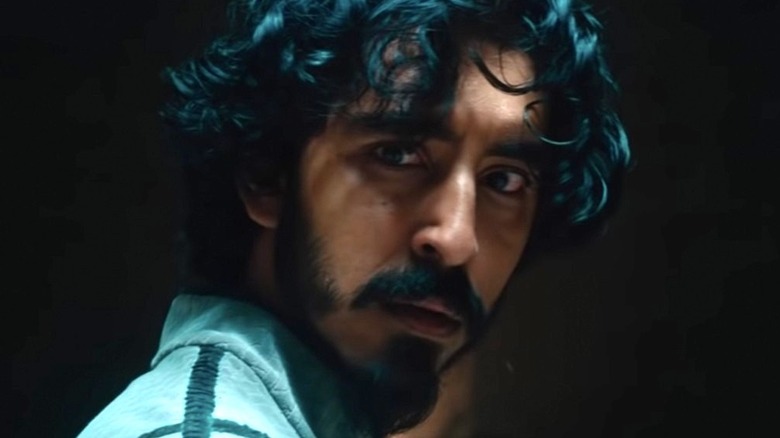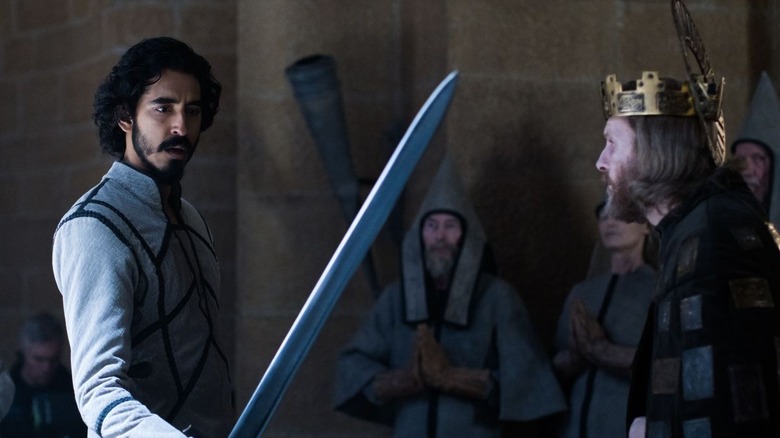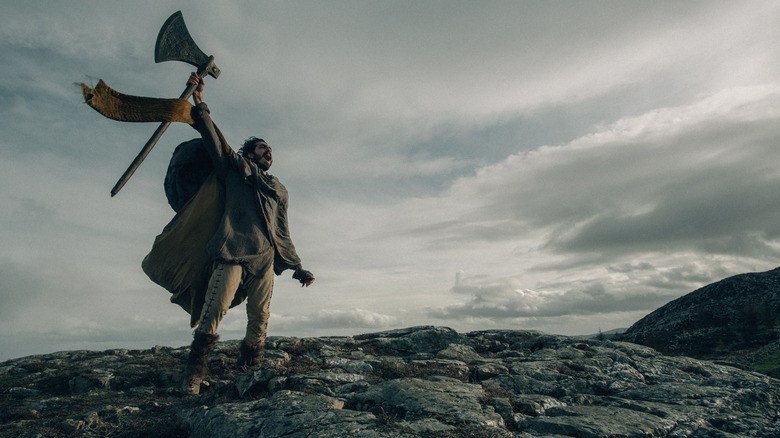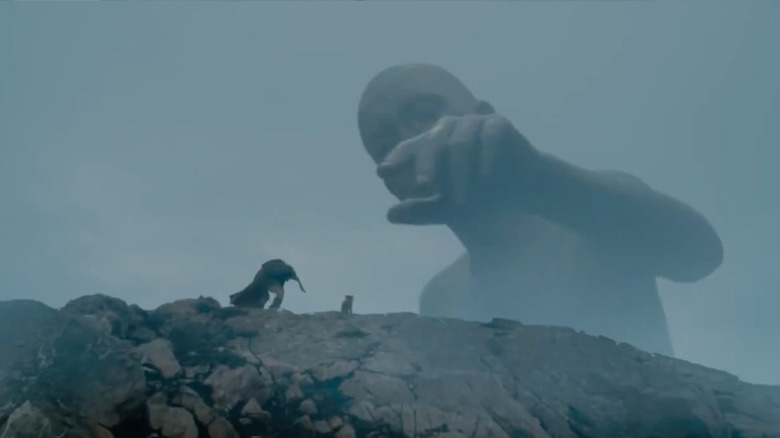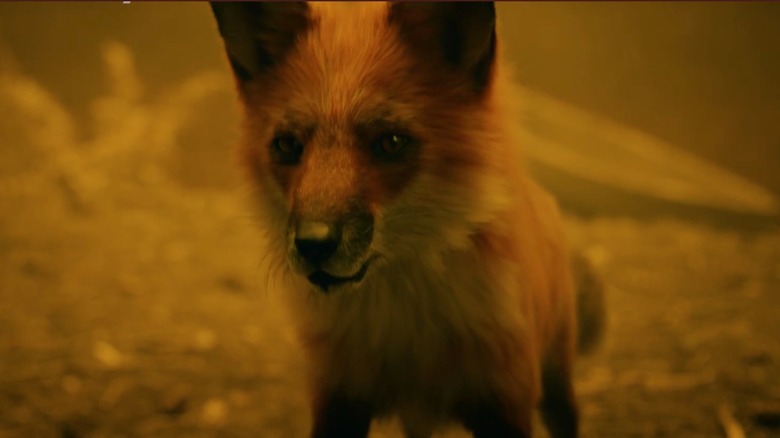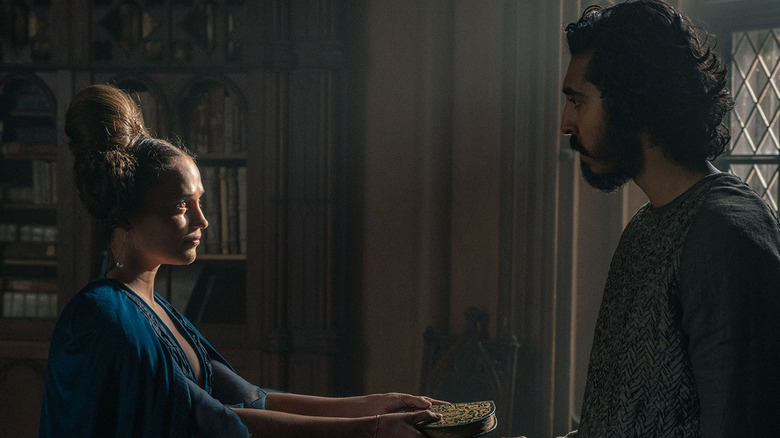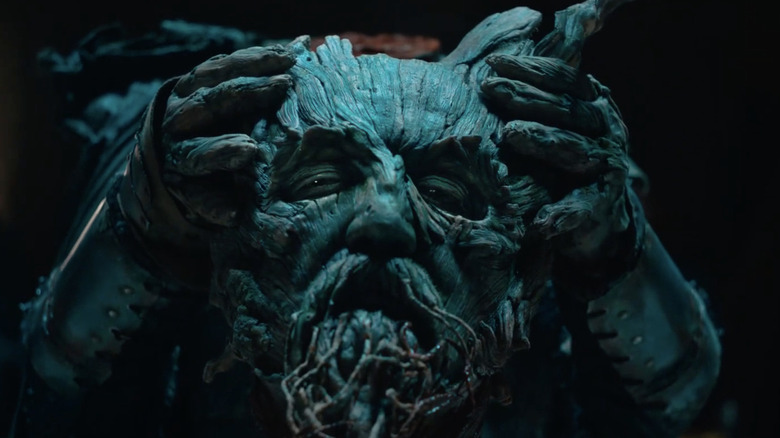The Biggest Unanswered Questions In The Green Knight
"The Green Knight" is adapted from a 14th century Arthurian story called "Sir Gawain and the Green Knight." Like a lot of stories from that era, things tend to get pretty bonkers when compared with the traditional, three-act structure we're accustomed to with modern storytelling. It's not just the kinds of stories told, the manner of creatures who appear, or the antiquated way of speaking or behaving — it's the structure of the stories themselves.
"The Green Knight" may, on its face, be a story about Gawain (Dev Patel) questing for his knighthood by engaging with the supernatural Green Knight in a not-so-friendly beheading game (yes, that's a real thing), but it's more than just a singular quest. Over the course of two hours, we get a number of small stories which are a part of Gawain's overall odyssey toward the Green Chapel and his fate. Many of those stories leave us with more questions than answers.
Few viewers would blame you if you walked out of the theater after watching "The Green Knight" with a lot of questions and very few answers. This is a sampling of some of the biggest questions we had — some that can be answered by investigating the original text, and some meant to be unanswerable.
Why does Gawain's mother summon the Green Knight?
When Gawain heads off to celebrate Christmas with the king (Sean Harris) and queen (Kate Dickie), his mother (Sarita Choudhury) opts to stay home. She says she isn't feeling up to partying, but she's very up to casting some spells: She and three other women perform a ritual which ultimately summons the Green Knight. And you would be absolutely right to ask why the heck did she'd do that. After all, if not for this summoning, Gawain would never have ended up in the situation he finds himself in.
"The Green Knight" never answers this question, but "Sir Gawain and the Green Knight" does — at least kind of. The thing to remember here is who the players are. The king and queen, for example, aren't just anyone — they are King Arthur and Queen Guinevere. And Gawain's mother is Arthur's sister, making her Morgan le Fey, an enchantress and not exactly a great sibling. In the original text, le Fay's intention is to frighten Guinevere and also prove that Arthur's knights aren't as heroic as they're made out to be.
Whether those motives remain the same for "The Green Knight" is unclear. One would think she might be upset that her son winds up connected with the Green Knight in such a lethal way, but she seems fine with it. Perhaps she resents her son — or perhaps she believes the quest Gawain must go on thanks to the Green Knight will lead to him succeeding Arthur as king. Either way, we're never supplied with a definitive answer.
Why is Gawain's axe in Winifred's cottage?
Shortly into Gawain's quest to find the Green Chapel, he comes upon a young man hovering over the dead bodies from a recent battle. The young man seems like he wants to help Gawain, but he turns out to be a thief. Both the thief and his two compatriots leave Gawain tied up while stealing both his horse and his axe (the one he got from the Green Knight at the beginning of the tale).
After escaping his bonds, Gawain comes upon a small cottage haunted by the ghost of its former resident, Winifred (Erin Kellyman). Winifred reveals that someone chopped her head off and dumped it in the nearby lake — she even asks Gawain if he was the one who killed her. Gawain decides to help Winifred by fetching her head and returning it to the rest of her dead body in the cottage. When he does, Winifred reveals that the Green Knight is someone Gawain knows (this will be important later) and Gawain's axe magically appears.
Where did the axe come from? Did the thief who stole the axe kill Winifred? That seems unlikely, since Winifred is already decayed to a full skeleton. However, time seems to operate very strangely in "The Green Knight," so it is possible.
Regardless, we never find out for sure who killed Winifred, or how Gawain's axe finds its way into her cottage — other than to say that maybe Gawain isn't quite all there. Speaking of which...
Are the giants real?
Gawain spends much of his journey without any human companionship. As we've seen, even when he does encounter other people, things don't work out terribly well for him. Beaten down by the elements and starving, he winds up eating some wild mushrooms; moments later, he vomits and begins to imagine moss growing all over his hands. Although the movie never states this explicitly, it's a safe bet that those mushrooms were a little bit poisonous and a lot hallucinogenic.
The real question is: how long do those hallucinations last? Furthermore, how reliable a narrator is Gawain even from the start? While tied up by thieves, he seems to imagine himself as a rotting skeleton that never escaped its bonds. That alone makes it difficult to know what's real and what isn't along Gawain's quest.
And things get even more unbelievable when Gawain runs into a group of naked giants roaming the countryside. He attempts to get them to carry him the rest of the way to the Green Chapel. Instead, they're warded off by a fox who spends much of the film following (and perhaps guiding) Gawain on his journey.
Are the giants real? "The Green Knight" never answers this question. The fact that he's never aided by the giants suggests that they're probably just a hallucination. In fact, since Gawain feeds the fox some of those wild mushrooms, it's possible they're both hallucinating — assuming the fox is real, of course.
What is the significance of the fox?
Weaving in and out of Gawain's journey to the Green Chapel is a fox who seems to act as companion and guide. They rest in a cave together, they eat those mushrooms together, and, by the end of the story, the fox even speaks to Gawain, cautioning him away from meeting with the Green Knight.
Is the fox friend or foe? And what does the fox represent in the larger narrative of "The Green Knight"?
Foxes hold all sorts of different symbolic meanings across history and cultures. They can represent that a solution is at hand, or they can represent a need for patience. Sometimes they're benevolent; sometimes they're tricksters meant to be eyed warily.
In the context of "Sir Gawain and the Green Knight," the fox is tied to a specific character — the Lay (Alicia Vikander), the wife of a lord (Joel Edgerton) Gawain encounters late in his travel. In the original text, Gawain stays with the pair in their castle and forms a pact with the Lord: the Lord will provide Gawain with the best food he captures in his hunt, and, in exchange, Gawain will give the Lord anything he gains during his stay in the castle.
During this time, the Lay kisses Gawain two times before giving him a magical, protective green belt (more on the belt later). The Lord struggles to succeed in his hunt that day — he is, of course, hunting a fox. The fox is meant to possess a similar guile and manipulative nature as the Lay does attempting to bed Gawain.
In "The Green Knight," the Lord captures the fox, only to let it get away after Gawain refuses to give up the belt. In other words, we're left open-ended over whether or not the fox can be trusted in the movie.
Who is the Sightless Woman?
The Lord and the Lay are not the only two people Gawain meets during his time in the Lord's castle. There is a third, ever-present figure throughout this part of the film: the grey-haired, perpetually blindfolded Sightless Woman. She appears during meals, and, more importantly, she's present when the Lay eventually succeeds in seducing Gawain with the green belt.
Who is the Sightless Woman and why is she there? At no point does "The Green Knight" directly answer this question. However, in "Sir Gawain and the Green Knight," she's Morgan le Fay — and that's relevant to the film as well.
At the start of his journey, Gawain is given what appears to be the same green belt by his mother. However, when Gawain is captured by thieves, they steal the belt along with most of his other belongings. He is completely shocked when the Lay somehow offers what seems to be the same green belt later.
One could hypothesize that it is the same green belt, and that it comes courtesy of the Sightless Woman who is actually Gawain's mother in disguise. We're never told that explicitly, but that is one possible interpretation. After all, both the Lay and Gawain's paramour back home, Essel, are portrayed by Alicia Vikander — so why couldn't his mother and the Sightless Woman secretly be the same person?
Who is the Green Knight?
Gawain has one ultimate end point for his journey — to meet the Green Knight in the Green Chapel on Christmas Day a year after their first encounter. We don't know why his mother conjured the knight and we also don't know who the Green Knight is beyond what appears to be a supernatural being incapable of death.
However, during Gawain's journey, Winifred tells him the Green Knight is someone he knows. Later, the fox wards Gawain away from the Green Knight, explaining that the figure is inhuman and utterly without mercy.
So who exactly is the Green Knight? The movie never actually explains this. However, in "Sir Gawain and the Green Knight," we're told definitively who he is — he's the Lord from the castle, entreated and enchanted by Morgan le Fay as a means to bring harm to Arthur and Camelot.
The film adaptation gives us no such connection between the Lord and the Green Knight. It's possible that they're the same person, but it's more likely that in this version, the Green Knight isn't so much a someone Gawain knows but a something.
The Green Knight represents the horrible knowledge that Gawain would make a bad knight, an unprotective father, and a tragically unfit king. The Green Knight brings Gawain this knowledge through a merciless vision so horrifying that Gawain chooses the be decapitated by the Green Knight rather than live.
Do we know who the Green Knight really is? No. But we do know what he is — Gawain's mortal fate.
